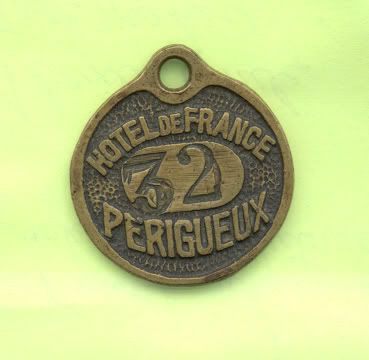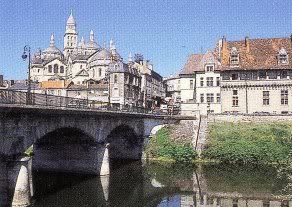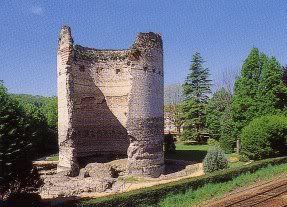Périgueux
© Thomas Wilson Shawcross 28 June 2005

I stayed in Room 32, Hotel De France,
and I have the brass key fob to prove it.
In the summer of 1979, I toured Southern Europe with Isabelle. We started in Madrid, moved on to Toledo, and then traveled across France and Italy by train. We saw some spectacular sights along the valley of the Dordogne River, and we visited charming little French towns with names like Sarlat and Domme. Actually, the names weren’t like Sarlat and Domme, they were Sarlat and Domme. And Périgueux.
To this day, Périgueux is one of my favorite places. I vowed to return some day, but so far I haven’t. Coincidentally, I was 32 years old when I was there, a coincidence that convinced Isabelle to steal the metal token that had been attached to our room key. When she presented it to me later, far from Périgueux, I was shocked, but now I am glad that she took it, as it is a prized souvenir for me now.
Périgueux was one of those happy accidents that can happen while traveling. It was not a planned stop. We had some planned stops, of course, including a week in Toulon, and visits to Lyon, Monaco, Florence, and Venice, but Périgueux came during one of the unplanned portions of the trip. We just got off the train at Périgueux, found a hotel, had dinner there, did some sightseeing, and got on the train again the following day (the advantages of the Eurail Pass).
Périgueux is an attractive little town in the Perigord region of France, which is the region that is famous for the production of goose pate. It was there that I learned the subtle differences between duck pate and goose pate (unfortunately, I have never been able to find a social situation in which I can impress people with this bit of arcane knowledge, but I keep hoping).
This is what Périgueux looks like:

Périgueux, France
I think of Périgueux often, as I have three key associations with it:
1. It was a very pleasant and attractive small town (about 30,000 people), and I really like small towns. Also, the hotel restaurant served a great dinner, and the overall ambience of the town was just so French!
2. It was the first place that really made me aware of how young America is versus other parts of the world (more on this later).
3. I associate it with the PBS television show Connections, which had a major impact on my worldview. I will discuss that first . . .
Connections is a three-part PBS television series narrated by James Burke (who wrote the book). In it, he explores historical “coincidences” and how they connect to each other, for example:
“How the popularity of underwear in the 12th century led to the invention of the printing press” or “How the arrival of the cannon led to the development of movies.”
source: http://www.roycecarlton.com/speakers/burke.html
Anyway, one of the stories told in Connections has to do with the impact that mass-production has had on our lives (versus the old days, when all objects were “hand-made” and one-of-a-kind). The narrator urged viewers to empty their pockets and see how many items they had that were mass-produced versus hand made. The narrator demonstrated this by extracting some coins, a small black rubber comb, and a machine-woven handkerchief from his pocket. All mass-produced. Nothing unique or “special.”
As I lay on my couch at that moment in Birmingham, Michigan, I decided to take the test. In my pocket, I had some keys and coins (machine-made and not one-of-a-kind) BUT I also had my Hotel de France key fob, and it was definitely hand-made. At least, it had a hand-made part where the room number, 32, had been stamped. This in itself presented an interesting challenge. After all, the modern implication was that “hand-made” items were special, as skilled artisans had crafted those items that have survived the test of time. But look at my key fob. It has one of the most inept stampings I have ever seen! But, I like it anyway. It occurs to me that my fob may now be two-of-a-kind, as the hotel has presumably had a replacement fob made, but it seemed the stamper they employed was probably one of the apes at the local zoo, so it was unlikely that the replacement was a clone of my fob.
The narrator assumed that I had nothing special in my pockets, but after all, who would have guessed I had a Périgueux key fob? The narrator went on to explain that I shouldn’t feel badly (I didn’t) because mass-produced items had a definite upside – they lowered the cost of items. He noted that if the television set on which I was watching the show had been hand-made, I probably could not have afforded to buy it. Well, he was right on that count.
Another reason that I think of Périgueux so often is that it was here that I realized how old Europe is. Of course, intellectually, I already knew that, but knowing something intellectually is not the same as receiving the “hot kiss at the end of a wet fist” blow of reality. Before dinner, Isabelle and I had walked about the town for a while and happened to come across what was obviously a very ancient ruin. It was a tower, about eighty feet tall, and it looked like an ancient castle keep tower. Later, at the hotel restaurant, I spoke in my best Franglais and inquired about that castle tower. Franglais, by the way, is the argot in which one uses French words for the easy words and English words for the hard ones, as in the English phrase “Please give me some wine, bread, and artichoke hearts,” which translates into Franglais as “S’il vous plait, donnez-moi du vin, le pain, et artichoke hearts.”
It turned out that the “castle keep” was actually the ruin of a two-thousand-year old Roman temple! Whoa! Two thousand years old? The town I live in now, Delray Beach, Florida, was founded in 1895, and the next town to the south, Boca Raton, was just scenery until 1926!

Vésonne Tower in Périgueux is older than Delray Beach
Actually, I have a fourth association with Périgueux now. Kurt Culbertson sent me a draft of his book “Landschaft und Gartenkunst: The German Influence on the Development of American Landscape Architecture,” and on page 144 it mentions a controversial practice of constructing artificial ruins in public parks: “For example, one of the chief horticultural journals of Germany has recently devoted many pages to the praise of artificially constructed ruins, and has given illustrations to show how they may best be constructed. Most travelers believe, we fancy, that these artificial ruins are creations of the earlier years of our century, when sentimentalism ran riot in Germany, and expressed itself in a thousand other ludicrous ways."
I suspect that the idea of having artificial ruins would not have occurred to American landscape architects who were not used to seeing two-thousand-year-old real ruins scattered around their home towns. Kurt’s book is very interesting, and I may write an essay about it some day.

I stayed in Room 32, Hotel De France,
and I have the brass key fob to prove it.
In the summer of 1979, I toured Southern Europe with Isabelle. We started in Madrid, moved on to Toledo, and then traveled across France and Italy by train. We saw some spectacular sights along the valley of the Dordogne River, and we visited charming little French towns with names like Sarlat and Domme. Actually, the names weren’t like Sarlat and Domme, they were Sarlat and Domme. And Périgueux.
To this day, Périgueux is one of my favorite places. I vowed to return some day, but so far I haven’t. Coincidentally, I was 32 years old when I was there, a coincidence that convinced Isabelle to steal the metal token that had been attached to our room key. When she presented it to me later, far from Périgueux, I was shocked, but now I am glad that she took it, as it is a prized souvenir for me now.
Périgueux was one of those happy accidents that can happen while traveling. It was not a planned stop. We had some planned stops, of course, including a week in Toulon, and visits to Lyon, Monaco, Florence, and Venice, but Périgueux came during one of the unplanned portions of the trip. We just got off the train at Périgueux, found a hotel, had dinner there, did some sightseeing, and got on the train again the following day (the advantages of the Eurail Pass).
Périgueux is an attractive little town in the Perigord region of France, which is the region that is famous for the production of goose pate. It was there that I learned the subtle differences between duck pate and goose pate (unfortunately, I have never been able to find a social situation in which I can impress people with this bit of arcane knowledge, but I keep hoping).
This is what Périgueux looks like:

Périgueux, France
I think of Périgueux often, as I have three key associations with it:
1. It was a very pleasant and attractive small town (about 30,000 people), and I really like small towns. Also, the hotel restaurant served a great dinner, and the overall ambience of the town was just so French!
2. It was the first place that really made me aware of how young America is versus other parts of the world (more on this later).
3. I associate it with the PBS television show Connections, which had a major impact on my worldview. I will discuss that first . . .
Connections is a three-part PBS television series narrated by James Burke (who wrote the book). In it, he explores historical “coincidences” and how they connect to each other, for example:
“How the popularity of underwear in the 12th century led to the invention of the printing press” or “How the arrival of the cannon led to the development of movies.”
source: http://www.roycecarlton.com/speakers/burke.html
Anyway, one of the stories told in Connections has to do with the impact that mass-production has had on our lives (versus the old days, when all objects were “hand-made” and one-of-a-kind). The narrator urged viewers to empty their pockets and see how many items they had that were mass-produced versus hand made. The narrator demonstrated this by extracting some coins, a small black rubber comb, and a machine-woven handkerchief from his pocket. All mass-produced. Nothing unique or “special.”
As I lay on my couch at that moment in Birmingham, Michigan, I decided to take the test. In my pocket, I had some keys and coins (machine-made and not one-of-a-kind) BUT I also had my Hotel de France key fob, and it was definitely hand-made. At least, it had a hand-made part where the room number, 32, had been stamped. This in itself presented an interesting challenge. After all, the modern implication was that “hand-made” items were special, as skilled artisans had crafted those items that have survived the test of time. But look at my key fob. It has one of the most inept stampings I have ever seen! But, I like it anyway. It occurs to me that my fob may now be two-of-a-kind, as the hotel has presumably had a replacement fob made, but it seemed the stamper they employed was probably one of the apes at the local zoo, so it was unlikely that the replacement was a clone of my fob.
The narrator assumed that I had nothing special in my pockets, but after all, who would have guessed I had a Périgueux key fob? The narrator went on to explain that I shouldn’t feel badly (I didn’t) because mass-produced items had a definite upside – they lowered the cost of items. He noted that if the television set on which I was watching the show had been hand-made, I probably could not have afforded to buy it. Well, he was right on that count.
Another reason that I think of Périgueux so often is that it was here that I realized how old Europe is. Of course, intellectually, I already knew that, but knowing something intellectually is not the same as receiving the “hot kiss at the end of a wet fist” blow of reality. Before dinner, Isabelle and I had walked about the town for a while and happened to come across what was obviously a very ancient ruin. It was a tower, about eighty feet tall, and it looked like an ancient castle keep tower. Later, at the hotel restaurant, I spoke in my best Franglais and inquired about that castle tower. Franglais, by the way, is the argot in which one uses French words for the easy words and English words for the hard ones, as in the English phrase “Please give me some wine, bread, and artichoke hearts,” which translates into Franglais as “S’il vous plait, donnez-moi du vin, le pain, et artichoke hearts.”
It turned out that the “castle keep” was actually the ruin of a two-thousand-year old Roman temple! Whoa! Two thousand years old? The town I live in now, Delray Beach, Florida, was founded in 1895, and the next town to the south, Boca Raton, was just scenery until 1926!

Vésonne Tower in Périgueux is older than Delray Beach
Actually, I have a fourth association with Périgueux now. Kurt Culbertson sent me a draft of his book “Landschaft und Gartenkunst: The German Influence on the Development of American Landscape Architecture,” and on page 144 it mentions a controversial practice of constructing artificial ruins in public parks: “For example, one of the chief horticultural journals of Germany has recently devoted many pages to the praise of artificially constructed ruins, and has given illustrations to show how they may best be constructed. Most travelers believe, we fancy, that these artificial ruins are creations of the earlier years of our century, when sentimentalism ran riot in Germany, and expressed itself in a thousand other ludicrous ways."
I suspect that the idea of having artificial ruins would not have occurred to American landscape architects who were not used to seeing two-thousand-year-old real ruins scattered around their home towns. Kurt’s book is very interesting, and I may write an essay about it some day.


2 Comments:
Hello there,
I am so glad you liked Périgueux (my home town). I really hope that you will have the time to come back again. You will see that the old town is even nicer than when you came in '79. Just wanted to comment on the Vesone Tower. Just a technical point really. The 'tower' is not 1000 years old, but 2000 years old. Does not make a great difference when compared to the age of most of the american towns and cities, I know.
Hope to see you there soon.
Anonymous Perigueux home-towner,
Merci! I have changed my text to show that Vesone Tower is 2,000 years old (even more mind-boggling than 1,000 years old). I plan to visit Perigueux again in 2006! A bientot.
Tom Shawcross
shaw8080@bellsouth.net
Post a Comment
<< Home